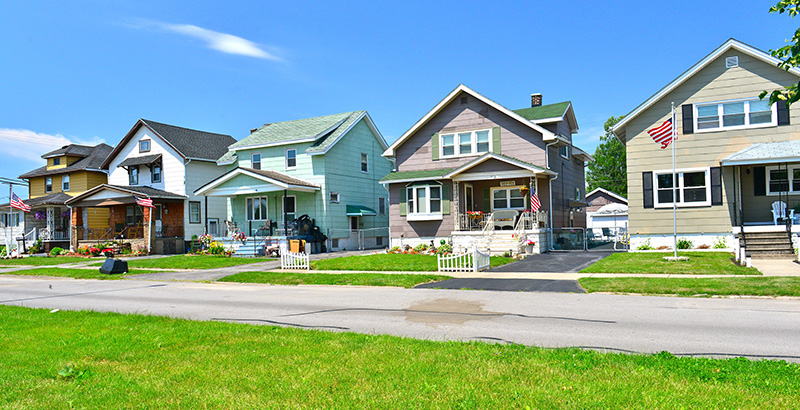
The benefits of building modernization through energy efficiency and electrification must be secured through policy changes, market transformation, utility action, consumer education and regulatory oversight. State-level legislation and agency policies can establish frameworks, policy goals and directives. They can direct proactive steps to be taken by key actors, ensure particular communities are prioritized and accelerate changes in the market. Put simply, legislation and proactive state policy can play a critical role of removing barriers and catalyzing action.
The status quo presents a number of barriers to building modernization that could be systematically addressed through legislation and coordinated policy actions at the state level. Some barriers are a product of inertia and a tendency for approaches to stay the same over time. But once these barriers are clearly identified, steps can be taken to remove them. The highlighted legislative options in each part of this toolkit demonstrate what states are doing to move toward a variety of relevant goals.
Increase Access and Participation in Agency Decisions
The United States is a representative democracy where citizens elect officials who then represent the citizens’ ideas and concerns in government.1 Public input into decision-making is a critical component of our democracy. Without public access to decision-making, the results of those decisions are unlikely to be equitable. Many state agency engagement practices, however, contain barriers to diverse public participation, including meeting times and places that make it difficult for working people to attend and arcane, technical language that is difficult for nonexperts to understand. Few states have requirements that agencies include an equity analysis in all significant planning, rule-making, adjudications, orders, programmatic and policy decision-making, and investments. Most states also lack an office or dedicated positions to advocate for the needs of overburdened communitiesoverburdened communities “Minority, low-income, tribal, or indigenous populations or geographic locations in the United States that potentially experience disproportionate environmental harms and risks. This disproportionality can be as a result of greater vulnerability to environmental hazards, lack of opportunity for public participation, or other factors” (U.S. Environmental Protection Agency). Largely synonymous terms include “marginalized,” “front-line,” “underserved” and “environmental justice” communities. and serve as a liaison between these communities and relevant state agencies.
The featured legislative options in this toolkit provide different methods to improve access to state agency processes and more explicitly consider equity in agency decisions. The options fall into two categories: requirements that act on all state agencies and requirements that act specifically on the public utility commission or environmental regulator. States may adopt many of these two types of provisions simultaneously. The provisions that contribute the most toward diversity, equity and inclusion are those that set clear expectations for governmental agencies to integrate equity and access into their processes, as well as provisions to create a permanent office of equity.
Bolster Weatherization and Home Repair Policies
Federal programs such as the Weatherization Assistance Program (WAP), a one-off, nonrecurring capital investment in energy efficiency measures, and the Low Income Home Energy Assistance Program (LIHEAP), a revenue support system to help pay the energy bills of eligible households, help address a portion of U.S. energy and housing burdens. Yet the need for these programs far exceeds the assistance available. Almost 85% of those who are income-eligible for the federal LIHEAP do not receive assistance2 because the program is oversubscribed. Similarly, while WAP has weatherized 7 million households, nearly 40 million more households are still eligible for assistance,3 but the program funds are not sufficient to provide it.
State action is necessary to fill in these gaps in federal resources and to cohesively align federal, state, philanthropic and utility resources to weatherize buildings, enable deeper retrofits and deliver greater value to federal and state taxpayers and ratepayers. States recognize the need to supplement federal resources, and state options presented in this toolkit include legislative authorization to:
- Provide funding for homes that require preweatherization measures to address mold remediation, moisture control, electrical issues, grading and roof repair.
- Provide improved coordination among state agencies for weatherization.
- Direct appropriate state agencies to braid funding resources from federal, state, philanthropic and utility resources together.
- Create a one-stop-shop application process and holistic whole-home retrofit process that coordinates agency programs and is easy for applicants to understand.
- Expand WAP and LIHEAP at the state level with health additions.
- Create state building retrofit plans focused on weatherizing and modernizing low-income housing.
 Tailor Funding and Finance Policies to Support Building Modernization
Tailor Funding and Finance Policies to Support Building Modernization
Building modernization improvements such as energy efficiency upgrades and electrified appliances frequently have a higher initial cost than fossil-fueled alternatives. Many people in the United States lack the financial resources to make these upgrades without assistance such as rebates, loans, tax credits or deductions. Additionally, low- and moderate-income households often live in homes with structural and maintenance issues, which require separate investment for repairs before installing new energy equipment. Easily understandable financing policies, targeted to all segments of the population, are necessary to make building modernization affordable.
Financing policies are important tools to spur the adoption of efficient building technologies and practices that are in the public interest. State legislation is often necessary to implement financing policies. For example, lawmakers pass bond legislation and authorize appropriations for incentives. They also change tax laws and state accounting and procurement rules — changes that can enable clean energy funding programs. Legislatures or executive branches can authorize outsourcing or performance contracting in facilities under their authority. They can pass legislation to create an independent, quasi-governmental entity such as a market accelerator or green bankgreen bank A financial institution that can leverage public funding to attract private capital for clean energy projects (including energy efficiency, renewable energy and other distributed energy resources) and other “green” investments.. State actions can help leverage federal support to the greatest benefit for residents by distributing federal funds through state energy offices and by utilizing state funds to fill critical gaps. The financing options discussed in this toolkit include:
- Rebates, loans and grants at the point of sale that reach low- and moderate-income customers, as well as other residential, commercial or industrial buyers.
- Recent examples of state actions to leverage federal funding.
- Income tax credits and deductions for individuals or businesses.
- State legislative efforts to transform the market toward offering more energy efficiency, renewable energy and electrification options.4
Update Codes and Standards to Keep Pace With Technology
Building policies such as energy codes provide significant benefits for occupants and the public, including lower energy use, reduced carbon emissions and reduced building operation costs. These policies also improve occupants’ health, safety and comfort. Some state and local governments are now looking beyond energy codes to explore new options — such as building performance standards, energy audits and assessments — to ensure that the building stock can contribute to achieving climate, health and other goals. Policymakers can use these tools to modernize building codes and policies that otherwise might remain stuck in the past. Updating building codes or enacting a building performance standard typically requires legislative direction.
The toolkit provides a variety of legislative examples for states seeking to achieve the most modern and efficient buildings via updated codes and standards:
- Adopt or change legislation to mandate automatic updates using the most recent model energy codes.
- Adopt or change legislation to allow for local jurisdictions to adopt a stretch code.
- Adopt a statewide building performance standard or legislation allowing for local jurisdictions to adopt such a standard.
- Develop a policy road map for electrification of buildings.
- Lead by example by decarbonizing assets the state owns or leases.
- Provide up-to-date information educating consumers on building modernization practices, technologies, financing and regulations.
Provide Guidance to Modernize Utility Regulation
Many states also have barriers in utility regulation that require legislative intervention and guidance. Some states prohibit electric utilities from pursuing activities that would increase load, which effectively bars utilities from promoting many electrified end uses that would increase efficiency and frequently decrease emissions. Other states prohibit fuel-switching, resulting in efficiency programs promoting only in-kind appliance changes, which can prevent consumers from choosing cost-effective options. Many utility commissions do not feel they have the authority to recognize beneficial electrificationbeneficial electrification Electrification that saves customers money, enables better grid management and reduces negative environmental impacts. as a least-cost resource or a resource that may count toward state climate goals. Finally, most states lack the direction to coordinate gas and electric utility planning in a way that would better account for all investment-related costs.
Electrification
Building electrification presents an opportunity not only to provide the same energy services more efficiently and at lower cost, but also to integrate buildings into the electric grid as a flexible load and make more efficient use of our electric system. Thus, policy direction to utilities and the regulatory commissions that oversee them has a direct impact on building modernization.
The legislative provisions in this part of the toolkit feature ways states have addressed these barriers by directing the utility commission and utilities to:
- Create beneficial electrification plans.
- Remove barriers to fuel-switching in existing legislation.
- Specifically focus electrification and other home improvement efforts on low-income and overburdened communities, particularly those with the highest energy burden.
Gas
Decision-makers in many jurisdictions are looking at options to mitigate risks to residents and utility customers during this period of energy transition and to advance policy goals. The options in this part of the toolkit provide examples of actions states are taking on this issue, with a focus on two key areas related to gas utilities: planning and line extension policies. The legislative options in this part show the array of approaches states are taking with regard to gas and are focused on four primary areas:
- Improved gas resource planning.
- Joint electric and gas planning.
- Options related to line extensions.
- Implementation of clean heat standards.
Develop a Skilled Energy Workforce
A critical mass of energy sector workers is reaching retirement age after decades of a lack of focus on training for the skilled trades and cuts in funding to vocational schools.5,6 This means that at a time when more consumers are wanting to modernize their homes and buildings with energy-efficient and electrified products, the United States does not have enough qualified workers to carry that out. This bottleneck poses a short-term obstacle to meeting greenhouse gas emissions reduction and clean energy goals. In the longer term, the challenge is to replace a retiring workforce, generate interest in energy sector jobs and meet a growing demand for clean energy projects.
States can overcome these challenges by enacting policies that generate interest in building modernization jobs and help members of underrepresented populations join this field. Workforce development strategies and legislative examples from various states demonstrate how policymakers can prepare a skilled and diverse building modernization workforce, including by:
- Updating state workforce and vocational programs to raise interest among younger students.
- Removing barriers in existing workforce development programs for certain justice-affected7 individuals.
- Revising eligibility requirements for state programs to offer training and access opportunities for “new-collar” workers — that is, people who develop job skills through nontraditional education paths.
- Increasing access to energy efficiency and building modernization jobs among underrepresented populations and businesses.
- Providing skills-based hiring connections, workforce development and community support for communities affected by the energy transition.
- Enabling more earn-as-you-learn programs through registered apprenticeships.8
Policy Coordination and Implementation
States could implement a suite of policies that include support for incentives, workforce development, meaningful agency access, regulatory alignment and financing strategies. Policies and programs must work together to optimize benefits. Policymakers may want to regularly assess policies in their state for cohesion. For example, state community health efforts — in particular through health and safety interventions for low- and moderate-income households — should coordinate with efficiency and electrification programs that provide health benefits and targeted toxic air emissions reductions. Programs that improve home resilience in the face of worsening storms should align with efficiency and electrification work to ensure homes are less vulnerable to extreme weather.
Local government input should also be sought for state actions such as building performance standards, codes or utility commission proceedings. State actions may be most effective when local permit processes are updated and streamlined, lowering costs and enabling policy implementation at the necessary speed and scale. The reverse is also true: Some beneficial actions that local governments could take are prohibited by the state, so states may consider removing these barriers (e.g., enabling legislation for stretch codes or other policies that are not feasible at the state level). Many policies may also benefit from engagement with neighboring states to maximize impact. And states should understand how federal preemption limits state action around certain policies, such as appliance and code requirements.
Conclusion
Building modernization policies provide an opportunity for states to save residents money when they heat and cool the buildings they live, work and play in. State action can also foster the growth of local jobs and businesses, improve public health, combat climate change and incorporate equitable outcomes. Real-world experience and studies show that these benefits can be achieved, but proactive legislative action and state planning are needed to realize the full magnitude of these benefits.
Endnotes
- U.S. Citizenship and Immigration Services. (n.d.). Democracy in the United States. https://www.uscis.gov/sites/default/files/document/lesson-plans/Government_and_You_handouts.pdf
- Bednar, D., & Reames, T. (2020, March 23). Recognition of and response to energy poverty in the United States. Nature Energy, 5, 432-439. https://www.nature.com/articles/s41560-020-0582-0
- Bednar & Reames, 2020. Additionally, while WAP funding may be used on rental properties, it rarely is, due to program design and other issues. For example, an analysis of a WAP pilot program in the state of Washington found that 92% of housing units served were single-family owner-occupied homes, because program requirements for landlord participation made it difficult to serve rental units. Schueler, V. (2018, July 23). The Washington state Weatherization Plus Health pilot: Implementation and lessons learned. Washington State University. https://nascsp.org/wp-content/uploads/2019/07/Washington-2018-WxHSummaryReport.pdf
- U.S. Environmental Protection Agency. (2015). Chapter 3. Funding and financial incentive policies. EPA energy and environment guide to action. https://www.epa.gov/sites/default/files/2017-06/documents/guide_action_chapter3.pdf
- Democratic staff of the U.S. Senate Committee on Energy and Natural Resources. (2016, August). Building an energy workforce for the 21st century, p. 7. https://www.energy.senate.gov/services/files/4269D9FB-3713-4371-AD66-CE9117A54E5D#:~:text=The%20average%20energy%20worker%20is,next%205%20to%2010%20years
- Kreisman, D., & Stange, K. (2019). Depth over breadth: The value of vocational education in U.S. high schools. Education Next, 19(4), 76-83. https://www.educationnext.org/depth-over-breadth-value-vocational-education-u-s-high-schools/
- “Justice-affected” or “justice-impacted” refers to people who have been incarcerated or detained in prison, immigration detention centers, local jails, juvenile detention centers or any other carceral setting. It also includes those who have been convicted but not incarcerated, charged but not convicted, or arrested. Bodamer, E., & Langer, D. (n.d.). Justice-impacted individuals in the pipeline: A national exploration of law school policies and practices. Law School Admission Council. https://www.lsac.org/data-research/research/justice-impacted-individuals-pipeline-national-exploration-law-school/
- U.S. Department of Labor. (n.d.). Registered apprenticeship program. ApprenticeshipUSA. https://www.apprenticeship.gov/employers/registered-apprenticeship-program
